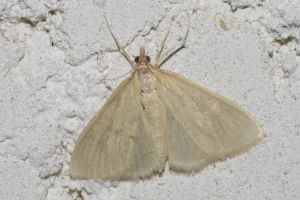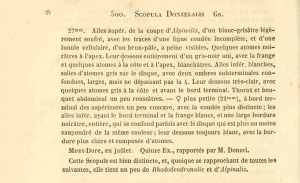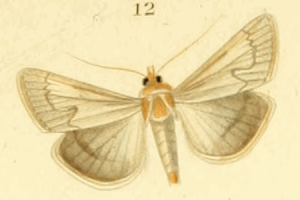

 +3Kontinente:EU
+3Kontinente:EU1. Lebendfotos
1.1. Falter
2. Diagnose
2.1. Erstbeschreibung
4. Weitere Informationen
4.1. Andere Kombinationen
- Scopula donzelalis Guenée, 1854 [Originalkombination]
4.2. Etymologie (Namenserklärung)
Guenée (1854) erhielt für seine Erstbeschreibung 15 Falter von Herrn Donzel.
4.3. Taxonomie
Das Taxon wurde auf Artebene beschrieben, später aber als Synonym zu Udea austriacalis gestellt, so auch noch bei Slamka (2013). Erst Mally et al. (2018) erhoben es wieder in den Artrang ("stat. rev."). Sie stellten dabei fest, dass die beim Barcoding ermittelten Unterschiede sich auch mit Unterschieden bei den Genitalien und kleineren äußeren Unterschieden (bes. Palpen) decken. Zum Barcoding-Ergebnis schrieben sie: "The five DNA barcoded specimens are identical in their DNA barcodes. The nearest neighbour is U. cretacea with 4.29 % minimum p-distance in the COI Barcode (see Tab. 3). The next-closest neighbour is U. rhododendronalis with a minimum interspecific COI p-distance of 4.76 %."
Schwesterart ist nach den genetischen Ergebnissen Udea carniolica, Udea austriacalis ist dann deren gemeinsame Schwester.
4.4. Faunistik
Locus typicus ist Mont-Dore (Frankreich, Region Auvergne-Rhône-Alpes, Département Puy-de-Dôme, Arrondissement Clermont-Ferrand); das Massif des Monts Dore ist dabei Teil des Zentralmassivs. Mally et al. (2018) führen Funde aus dem Zentralmassiv und den Pyrenäen (Frankreich, Andorra, Spanien) an. Die Art löst damit die in den Alpen verbreitete Udea austriacalis nach Westen ab. In den Pyrenäen tritt sie dabei durchgehend gemeinsam mit Udea rhododendronalis auf.
4.5. Typenmaterial
Mally et al. (2018) legten Lectotypen fest: "Lectotype ♀ “Puy de Dôme | Mont Dore | Guenée”, [orange label] “Cotype”, [circular label with yellow margin] “Co- | type”, “Paravicini Coll. | B. M. 1937-383.”, NHMUK loan label NHMUK010589059, [salmon-pink label] “DNA voucher | Lepidoptera | ZMBN 2017 | [transverse] no. 473”, Mally prep. no. 1123 ♀ (NHMUK); 3 Paralectotypes: 1♂ with labels as Lectotype, NHMUK loan label NHMUK010589061, [salmon-pink label] “DNA voucher | Lepidoptera | ZMBN 2017 | [transverse] no. 474”, Mally prep. no. 1124 ♂ (NHMUK); 1♂ with labels as Lectotype plus [brown label] “Donzelalis | Gn. Mont Dore”, NHMUK loan label NHMUK010589062, [salmon-pink label] “DNA voucher | Lepidoptera | ZMBN 2017 | [transverse] no. 475”, Mally prep. no. 1125 ♂ (NHMUK); 1♀ [abdomen missing] “Puy de Dôme | Mont Dore | Guenée”, [orange label] “Cotype”, [circular label with yellow margin] “Co- | type” (NHMUK)."
(Autor: Erwin Rennwald)
4.6. Literatur
- Erstbeschreibung: Guenée, A. (1854): Histoire naturelle des insectes 8. Deltoïdes et Pyralites: 1-448, explication des planches p. 1-6, pl. 1-10. Paris (Librairie encyclopédique de Roret).
- Lectotypus-Festlegung: Mally, R., Huemer, P. & M. Nuss (2018): Deep intraspecific DNA barcode splits and hybridisation in the Udea alpinalis group (Insecta, Lepidoptera, Crambidae) – an integrative revision. — ZooKeys 746: 51–90. doi: 10.3897/zookeys.746.22020. [zum open-access-Artikel auf pensoft.net]
- Slamka, F. (2013): Pyraloidea of Europe (Lepidoptera). Volume 3. Pyraustinae & Spilomelinae. Identification - Distribution - Habitat - Biology. — 357 S., 133 Taf. mit Genitalabb., 31 Farbtaf. mit fast 1100 Bildern – Bratislava (Eigenverlag František Slamka).









